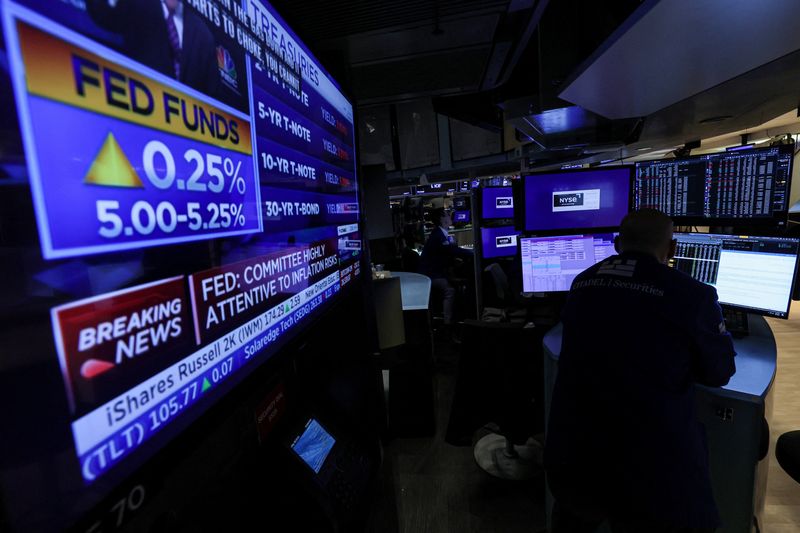LONDON (Reuters) – The U.S. Federal Reserve is close to the end of its interest rate hiking cycle, while the European Central Bank on Thursday slowed the pace of its aggressive tightening.
Turmoil in the banking sector, particularly in the United States, is adding to central banks’ difficulties, leaving them juggling the need to control inflation through higher rates, and a desire not to add further strain on the financial system.
Overall, 10 developed economies have raised rates by a combined 3,490 basis points (bps) in this cycle to date.
Japan is the holdout dove.
Here’s a look at where policymakers stand, from hawkish to dovish.
Graphic: The race to raise rates – https://www.reuters.com/graphics/GLOBAL-MARKETS/akpeqjexlpr/chart.png
1) UNITED STATES
The Fed raised rates by a quarter point to 5.00-5.25% on Wednesday, continuing its most aggressive series of hikes since the 1980s.
The U.S. central bank offered markets some succour, dropping from its policy statement language that it “anticipates” further rate increases.
Fed chief Jerome Powell said inflation remains the chief concern, and that it is therefore too soon to say with certainty that the rate-hike cycle is over.
Graphic: Fed hikes and opens door to pause – https://www.reuters.com/graphics/GLOBAL-MARKETS/zgpobygrmvd/chart.png
2) NEW ZEALAND
The Reserve Bank of New Zealand shocked markets in April by unexpectedly raising its cash rate by 50 bps to 5.25%, the highest in over 14 years. Not one economist polled by Reuters predicted the move.
The central bank said inflation was still “too high” with employment beyond “maximum sustainable levels”. Analysts revised their forecasts for the peak in interest rates up to 5.5%.
Graphic: RBNZ stuns market with bigger rate rise – https://www.reuters.com/graphics/NEWZEALAND-ECONOMY/mopakbgjapa/chart.png
3) CANADA
The Bank of Canada in March became the first major central bank to halt monetary tightening during this cycle.
The BoC’s key overnight rate remains at 4.50%, with the aim to hold it there as long as inflation drops to 3% at about mid-year.
Market participants believe there’ll be no change until next year, according to a central bank survey released on April 24.
Graphic: Bank of Canada holding off on hikes – https://www.reuters.com/graphics/GLOBAL-CENTRALBANKS/byvrlewjqve/chart.png
4) BRITAIN
Grappling with the highest inflation in western Europe, the Bank of England is widely expected to raise rates by 25 bps at its May 11 meeting.
Markets price a terminal rate close to 5% by November.
The BoE in April forecast a drop in inflation, although data then showed a larger than expected increase in wage growth.
Graphic: BoE’s inflation fight continues – https://www.reuters.com/graphics/GLOBAL-CENTRALBANKS/akveqxldevr/chart.png
5) AUSTRALIA
Australia’s central bank confounded expectations with a 25 bps hike in May, when markets had expected a pause.
The cash rate now stands at a 12-year high of 3.85% and the RBA said “some further tightening” may be required to ensure inflation returns to target in a “reasonable timeframe”.
Graphic: An unexpected rate hike – https://www.reuters.com/graphics/GLOBAL-MARKETS/THEMES/znvnbqkqzvl/chart.png
6) NORWAY
Norway’s central bank raised its main interest rate by 25 bps on Thursday to 3.25%. It said another hike in June was likely – and that more could be needed if the currency stays weak.
The Norwegian crown has had a terrible year, with the dollar up almost 9% against the currency in 2023. Meanwhile, inflation is still hot, with the core rate picking up to 6.2% in March.
Graphic: Norges Bank continues hiking rates – https://www.reuters.com/graphics/GLOBAL-CENTRALBANKS/zjpqjolmrvx/chart.png
7) EURO ZONE
The ECB raised its deposit rate by 25 bps on Thursday to 3.25%, its seventh successive hike this cycle but the smallest since it started lifting rates last summer.
The central bank kept its options open on future moves as it continues fighting stubbornly high inflation in the euro zone.
President Christine Lagarde said while monetary policy is no doubt restrictive, it is not yet “sufficiently restrictive”, noting that the “inflation outlook is too high and has been so for too long.”
Graphic: ECB eases the pace of interest rate hikes – https://www.reuters.com/graphics/GLOBAL-CENTRALBANKS/znvnbqwdqvl/chart.png
8) SWEDEN
The Riksbank raised borrowing costs by 50 bps on April 26 to 3.5% but said it was nearly finished with policy tightening, prompting a drop in the Swedish crown.
Sweden’s underlying rate of inflation, which strips out energy prices, eased to 8.9% in March but remains well above the central bank’s 2% target.
While investors had previously expected rates to peak at 4%, the Riksbank suggested only one more 25 bps hike is likely.
Graphic: Riksbank says nearly done with hikes Riksbank says nearly done with hikes – https://www.reuters.com/graphics/GLOBAL-CENTRALBANKS/gkplwajqevb/chart.png
9) SWITZERLAND
The Swiss National Bank raised its main interest rate by 50 bps in March to 1.5%, saying UBS’s emergency takeover of Credit Suisse had “put a halt” to the chance of a banking crisis.
Swiss inflation cooled to 2.9% in March, from 3.4% in February, but remained above the SNB’s target band for the 13th straight month.
Traders expect a further 25 bp hike in June, market pricing suggests.
Graphic: SNB hints at further rate hikes ahead – https://www.reuters.com/graphics/CEN-WRAP/lgpdkaboevo/chart.png
10) JAPAN
The Bank of Japan looks set to remain the world’s most dovish central bank under new governor Kazuo Ueda.
At Ueda’s first meeting last week the BOJ maintained its ultra low rates and its yield curve control policy that caps interest rates on longer term government bonds.
The BOJ also announced a plan to review its past monetary policy moves but said this exercise will take one-and-a-half years.
Graphic: Ueda maintains ultra-low interest rates – https://www.reuters.com/graphics/GLOBAL-MARKETS/THEMES/akveqjkzqvr/chart.png
(Reporting by Samuel Indyk, Nell Mackenzie, Dhara Ranasinghe, Alun John, Naomi Rovnick, Harry Robertson and Chiara Elisei; Graphics by Vincent Flasseur, Sumanta Sen and Pasit Kongkunakornkul and Riddhima Talwani; Editing by Christina Fincher)
